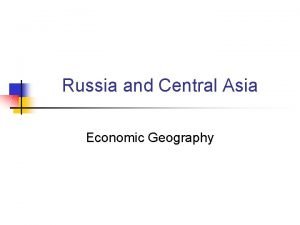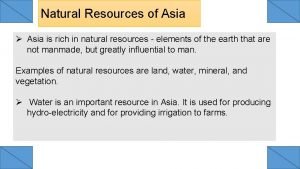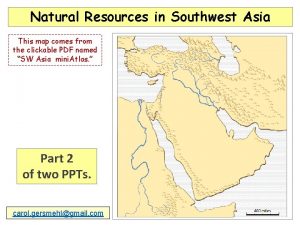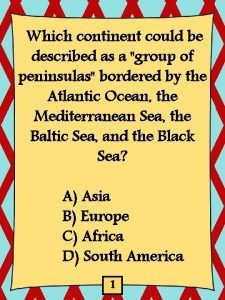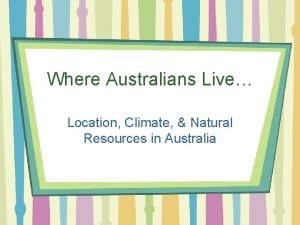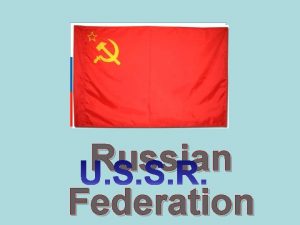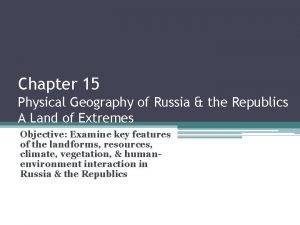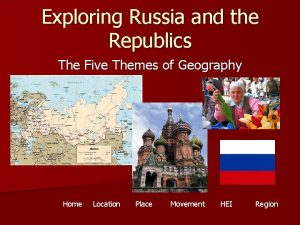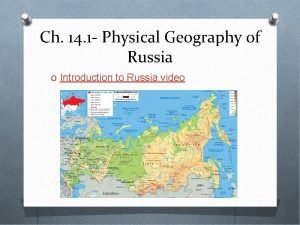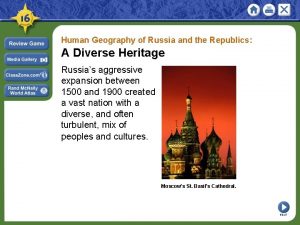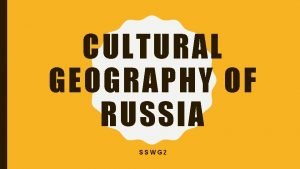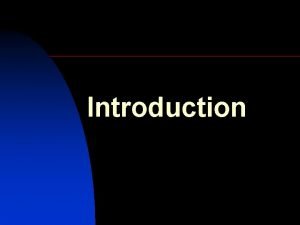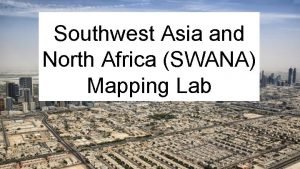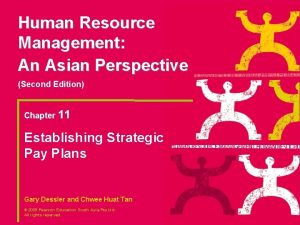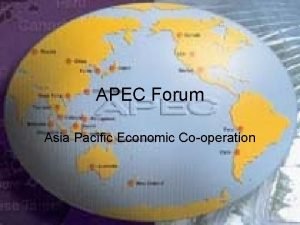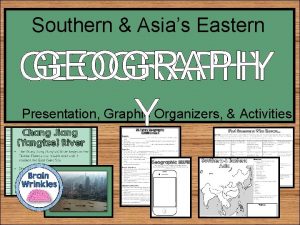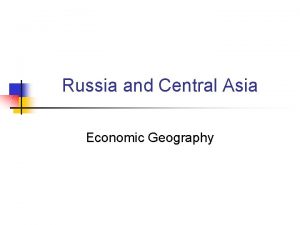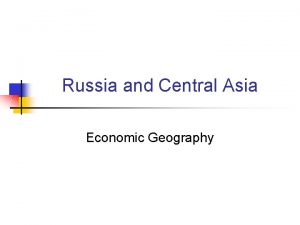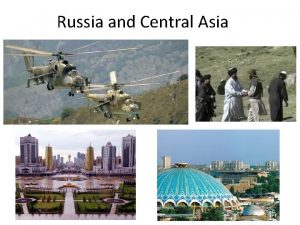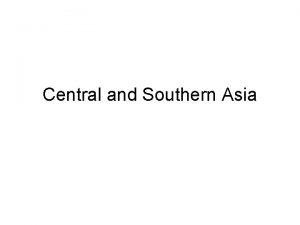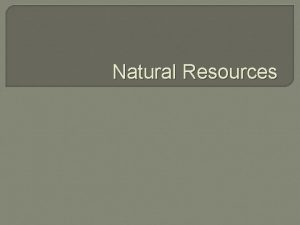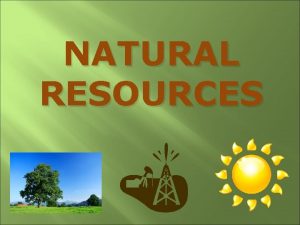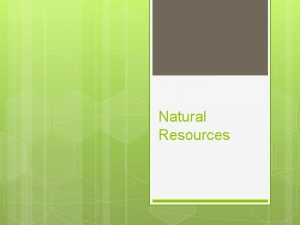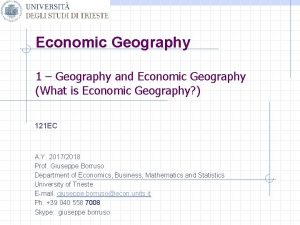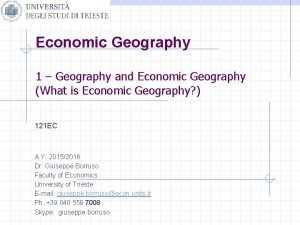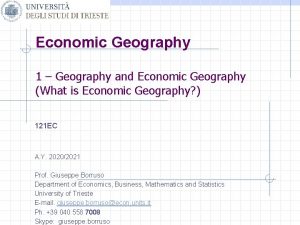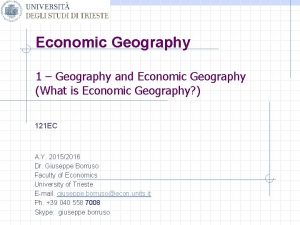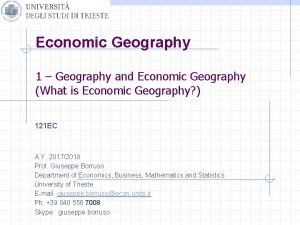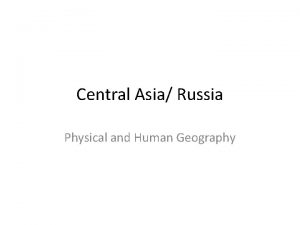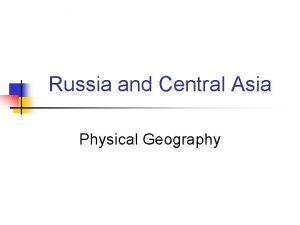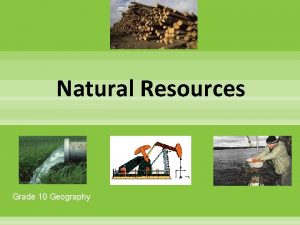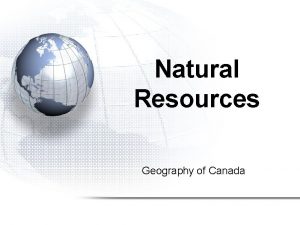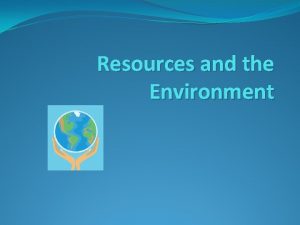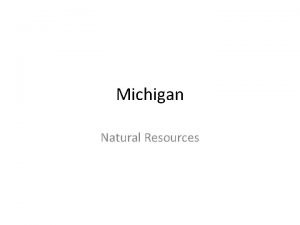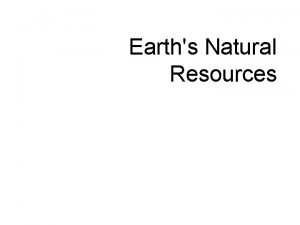Russia and Central Asia Economic Geography Natural Resources






















- Slides: 22

Russia and Central Asia Economic Geography

Natural Resources n Russia and Central Asia have many different types of natural resources, both renewable and nonrenewable.

Renewable Resources A. B. C. Russia has timber in Siberia. Most of Siberia is covered in Taiga. Russia has a lot of arable land, but most of it is in Western Russia has fish in the Black Sea, Caspian Sea, and Pacific Ocean.


Agriculture n Cotton is grown in Central Asia around the Aral Sea. The Aral Sea has been shrinking because of over irrigation of the rivers that flow into it.

Nonrenewable Resources n n Russia has fossil fuels such as oil, coal, and natural gas. There is oil on the bottom of the Caspian Sea. The natural gas in Russia is in Siberia on the Arctic coast. Russia consumes less oil than it extracts so it is able to export crude oil on the world market.

Nonrenewable Resources n Russia has many minerals such as aluminum, copper, lead, iron, zinc, gold, and silver.

Energy Resources n Russia has abundant sources of natural gas, coal, and oil. Russia also produces energy with nuclear power and hydroelectric power.

Chernobyl n In 1986, the Chernobyl nuclear power plant located in the Ukraine exploded. The explosion released massive amounts of radiation and the entire city of over 300, 000 people had to be evacuated.

Oil Pipelines n The Russian economy has been expanding because of increased investment in the oil industry. After the fall of communism many foreign companies invested in the Russian oil industry.




Capital Resources A. B. Western Russia has a well developed infrastructure to include a system of railroads, and canals. Siberia has a poor infrastructure. The Trans-Siberian railroad runs through Siberia but there are not many roads or railroads.

Trans-Siberian Railroad A. B. C. Novosibirsk became an important city after the Trans-Siberian Railroad was completed. (Remember site and situation!) Site = The physical location of a city Situation = The geographic, political, or economic factors around a city that make it important

Economic System n From 1917 to 1990 Russia was communist and it had a command economy. In a command economy the government controls all means of production. People cannot own land or businesses.

Economic System n n Before 1917, Russia was ruled by a Tsar. He was an emperor and had absolute power. After 1917, Russia was ruled by the Soviets. The Soviet Union refers to Russia, the countries of Central Asia, and some countries in Eastern Europe.

Warsaw Pact Countries

Warsaw Pact n The Warsaw Pact was a group of countries led by the Soviet Union that were communist. In order to combat the Warsaw Pact the United States created NATO (North Atlantic Treaty Organization).

Economic Challenges n The transition from a command to free market economy has been difficult but recently the economy of Russia has shown steady growth and standards of living are increasing.

Economic Challenges n A. B. C. There is widespread pollution in Russia. A few examples are: Oil spills from poorly maintained pipelines. Radioactive waste from nuclear power plants and nuclear submarines. Air pollution from factories with poor air quality standards.

Economic Challenges n The resources in Siberia are difficult to develop due to climate, limited transportation links, and vastness of the country.
 What are russia natural resources
What are russia natural resources Is asia rich in natural resources
Is asia rich in natural resources Southwest asia natural resources
Southwest asia natural resources Which letter represents the danube river?
Which letter represents the danube river? Climate of australia
Climate of australia Saint basil's cathedral
Saint basil's cathedral Chapter 15 physical geography of russia and the republics
Chapter 15 physical geography of russia and the republics Russia resources
Russia resources Russia and the eurasian republics physical map
Russia and the eurasian republics physical map Vocabulary activity 15 the cultural geography of russia
Vocabulary activity 15 the cultural geography of russia Reteaching activity 14 physical geography of russia
Reteaching activity 14 physical geography of russia Human geography of russia
Human geography of russia Russia 5 themes of geography
Russia 5 themes of geography River in central russia
River in central russia Kums definition geography
Kums definition geography Physical map of swana
Physical map of swana What is the transformative process of operations management
What is the transformative process of operations management Fixed resources and variable resources
Fixed resources and variable resources Pay grades
Pay grades Comparative systems worksheet answer key
Comparative systems worksheet answer key Apec forum
Apec forum What is economic growth and development
What is economic growth and development Se asia geography cloze notes 1
Se asia geography cloze notes 1
